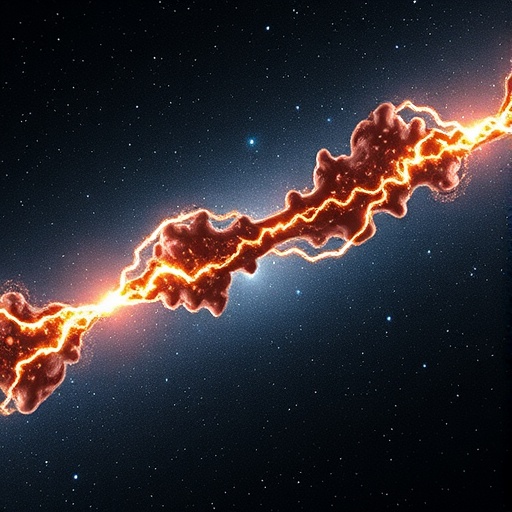In the vast realm of cosmic exploration, the interaction between galaxies offers an unprecedented opportunity to understand the dynamics and the ecological roles played by different galactic structures in the universe. Recently, a groundbreaking study focused on the radio galaxy NGC 4532 and its interaction with DDO 137 has shed new light on these celestial phenomena. Utilizing the powerful Australian Square Kilometer Array Pathfinder (ASKAP), researchers have meticulously analyzed neutral hydrogen emissions, unveiling intricate details about these galaxies’ behaviors within the rich ecosystem of the Virgo cluster.
The research team, comprising leading astronomers and astrophysicists, embarked on this ambitious study as part of the WALLABY pilot survey. Their purpose was to explore the extensive interactions occurring between NGC 4532 and its neighboring dwarf galaxy DDO 137. The Virgo cluster, known for its densely packed galaxy population, serves as a perfect laboratory for studying such cosmic interactions. This research aims to advance our understanding of how galaxies influence one another through gravitational forces, gas exchanges, and overall structural evolution.
The ASKAP, with its advanced technology and high sensitivity, played a pivotal role in detecting neutral hydrogen in and around NGC 4532. This imaging not only provides a glimpse of the gaseous components that are often invisible in optical telescopes, but also reveals how these gaseous structures interact during significant galactic events. The team has provided detailed observations, drawing compelling comparisons between the radio and optical images of these galaxies, thereby illustrating the importance of multi-wavelength observations in astrophysical research.
Astrophysicists are particularly interested in NGC 4532 because it exemplifies a more massive galaxy showcasing features of interaction, which can provide insights into the processes that influence galaxy evolution. The study shows that NGC 4532 is not just a solitary entity but part of an intricate web of cosmic activity. Its interaction with DDO 137 highlights the gravitational pull that larger galaxies exert on their smaller companions, leading to phenomena such as tidal stripping, where material is ripped away from the smaller galaxy due to the gravitational forces at play.
The extensive observations conducted as part of this survey revealed significant details about the morphology and velocities of neutral hydrogen gas in both galaxies. By cataloging these features, researchers hope to reconstruct the history of galaxy formation and subsequent evolutionary paths found within these fascinating celestial objects. This comprehensive method provides a canvas that illustrates the complex dance of interaction occurring on massive scales.
Furthermore, the research sheds light on the methods used in conducting the meta-analysis, which is crucial for interpreting the findings accurately. By collating data from various previous studies alongside the new observations, the researchers could form a cohesive understanding that extends beyond mere snapshot observations. Such meta-analytical approaches allow astrophysicists to assess larger trends in galaxy interactions and their implications for dark matter and dark energy theories.
The impact of the research extends beyond academic circles and resonates with the public interest in cosmic phenomena. The striking visual imagery captured through the collaboration between radio astronomy and optical surveys offers a tangible glimpse of the universe’s complexity. With potential implications for educational initiatives and public outreach, the findings could capture the imagination of both budding astronomers and the general populace, inspiring deeper inquiry into the cosmos.
The integration of these cross-disciplinary findings provides new dimensions to the critical ongoing debate concerning the fate of galaxies within clusters. Given that environments such as the Virgo cluster can influence galaxy evolution dramatically, understanding these dynamics is essential for building predictive models of cosmic evolution. The NGC 4532 and DDO 137 case studies thus stand as a beacon, illuminating the opportunities missed in previous models that did not fully factor in interactive processes.
Moreover, while the focus is primarily on radio emissions, it is worth noting the compound elements that contribute to the overall characterization of a galaxy. Spectroscopy plays a role in determining the composition of light from these galaxies, enhancing understanding not only of their physical properties but also of their past interactions and deviations from traditional evolutionary paths.
As these findings circulate within the scientific community, they have the potential to cultivate collaborative projects that push the frontiers of knowledge further. By establishing connections between diverse fields such as cosmology, astrophysics, and particle physics, researchers hope to forge new paths towards answering age-old questions about the universe’s origins and its ultimate trajectory.
In conclusion, the analysis of the interactions between NGC 4532 and DDO 137 marks a significant milestone in our endeavor to comprehend the complexities of galaxies and their dynamic relationships. The implications of this research extend far-reaching effects, stimulating new discussions surrounding galaxy formation, the influence of dark matter, and cosmic evolution. As researchers dig deeper into the fabric of space and time, the stories told by these celestial bodies continue to inspire and ignite the human curiosity that has driven exploration throughout history.
Subject of Research: Not applicable
Article Title: WALLABY pilot survey: the extensive interaction of NGC 4532 and DDO 137 with the Virgo cluster
News Publication Date: 23-Sep-2025
Web References: http://dx.doi.org/10.1093/mnras/staf1443
References: Monthly Notices of the Royal Astronomical Society
Image Credits: Credit: ICRAR and D.Lang (Perimeter Institute).
Keywords
Galaxies, Interstellar Medium, Radio Astronomy, ASKAP, Galaxy Evolution, Cosmic Interactions, Virgo Cluster, Neutral Hydrogen, Tidal Stripping, Astrophysics, Spectroscopy, Meta-analysis.




